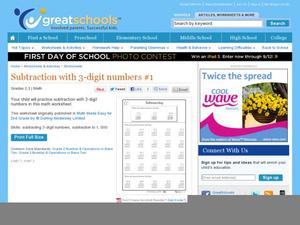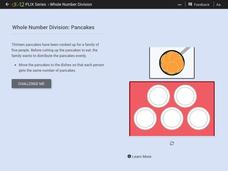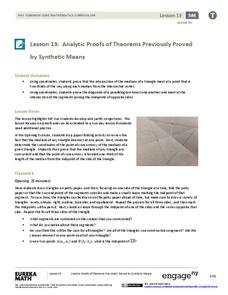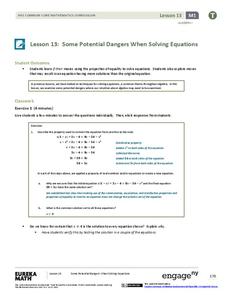Equality and Human Rights Commission
How Do Human Rights Work?
Do human rights apply to children? Scholars learn of three children asking for help to determine their rights and how to handle specific situations. Class members must research any laws pertaining to the requested right and how the...
Curated OER
Cartoons for the Classroom: Sunshine Week
Do the people have the right to know? Is there a real dialogue between U.S. political powers and the American people? Upper graders evaluate these concepts and more when they critically examine two political cartoons depicting Sunshine...
Curated OER
Typical Numeric Questions for Physics I - Atomic Spectra
Seven practice problems are presented to physics pros in this assignment. Given the wavelengths, they perform computations for emission spectra. This brief worksheet makes an appropriate pop quiz.
Curated OER
Location on a Grid
Make coordinate pairs more engaging by having beginners color-code a grid based on given locations. The grid has numbers along the y-axis and letters along the x-axis, introducing them to the ordering of coordinate pairs with the x-axis...
Curated OER
Symmetry
These symmetrical shapes are only half-completed, so scholars finish them by drawing the other side of the line of symmetry. Because your class won't recognize these abstract shapes, they will get authentic practice with this objective....
Curated OER
Reading Tally Chart
As learners explore data analysis have them practice reading tally charts using these examples. They answer basic questions about each of three charts, employing addition and subtraction skills. For example, a chart tallying t-shirts...
Discovery Education
Subtraction with 3-Digits Numbers #1
Looking for a simple way to practice 3-digit subtraction? Use this review page to reinforce your second and third graders' subtraction skills. It includes twenty problems for them to solve, as well as five problems using money. Useful as...
Curated OER
Simple Tally Charts and Bar Graphs
Introduce your first graders to the world of tally marks, bar graphs, and the organization of data. Pupils determine a favorite ice cream flavor based on tally marks, then use a bar graph to answer some questions about sports. There are...
BioEd Online
Muscles and Bones in Space
Being an astronaut takes not only high mental acuity, but also a high level of physical fitness, especially for those who spend a long amount of time away from Earth, such as the astronauts serving on the International Space Station....
Baylor College
Post-Assessment: And Now, What Do You Know About Microbes?
Your life science class works in their groups to review the concept maps that they have constructed over the course of a microbiology unit. They share what they have learned with the rest of the class. In a second session, they are given...
CK-12 Foundation
Whole Number Division: Pancakes
Given 13 pancakes and five plates, learners are asked to distribute the pancakes evenly among the plates. Is it possible? Will there be any remainders? These are the questions pupils are asked to answer after manipulating an...
Curated OER
Prime and Composite Numbers
Sixth graders investigate the concept of prime and composite numbers. They use a review of multiplication to help explain factoring. Students are taught the definition of a prime and composite number and then practice independently.
Curated OER
Prairie Voices
Fifth graders compare and contrast a one room school house in Iowa in the past with how they go to school today. In this school lesson plan, 5th graders read about rural families and the controversies that they endured in the time of one...
Curated OER
Doubles Plus One Math Game
Students participate in a dice game. In this doubles lesson, students are paired up and use dice to create double facts. Students solve the equations.
Curated OER
Probability Concepts (Practice 20.2)
For this probability worksheet, learners solve 16 problems pertaining to probability and likely, less likely, certain and impossible outcomes.
Curated OER
Unit 13: Graphs, Correlation, Line of Best Fit
Students explore the concepts of graphs, correlations, line of best fit, and the dipstick problem. In this graph, correlation, line of best fit and dipstick problem lesson, students solve problems on the above mentioned topics. ...
Curated OER
Venn Diagrams With the Pain And the Great One
Students read the story, The Pain and the Great One, written by Judy Blume, and discuss the characters and the sequence of events. They compare/contrast the two main characters using Venn diagrams.
Curated OER
One-Difference Classification Train
Students practice their classification skills through hands-on practice. Working in groups, students identify various ways in which similar items can be classified. Given a kit of similar items, students classify objects in multiples...
Curated OER
Two Way Communication
Middle schoolers play a modified game of hangman. One students is the drawer and the other the communicator. They also experiment playing the game in which both middle schoolers can talk.
Curated OER
Houghton Mifflin Social Studies/Chapter 13, Lesson 1 The Past Shapes the Future (pp. 292-295)
Fourth graders reflect upon the events of the past in order to make cognitive connections to present or future history. Students use Blooms Taxonomy to attain higher levels of thinking.
Curated OER
Make It or Break It
Young scholars study about "breaking news" by analyzing the New York Times' coverage of the July 2006 bombing of seven commuter trains in Mumbai, India. They write their own breaking news stories for homework.
EngageNY
Analytic Proofs of Theorems Previously Proved by Synthetic Means
Prove theorems through an analysis. Learners find the midpoint of each side of a triangle, draw the medians, and find the centroid. They then examine the location of the centroid on each median discovering there is a 1:2 relationship....
EngageNY
Proof of the Pythagorean Theorem
What does similarity have to do with the Pythagorean Theorem? The activity steps through the proof of the Pythagorean Theorem by using similar triangles. Next, the teacher leads a discussion of the proof and follows it by an animated...
EngageNY
Some Potential Dangers When Solving Equations
Need a less abstract approach to introducing extraneous solutions? This is it! Young mathematicians explore properties used to solve equations and determine which operations maintain the same solutions. They...























